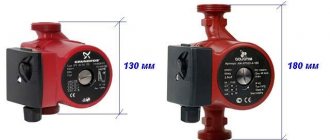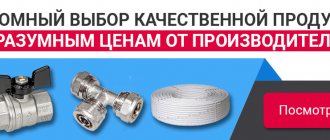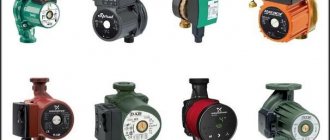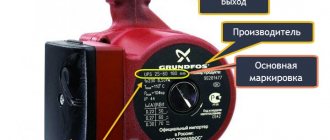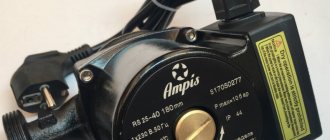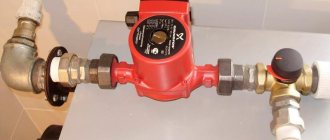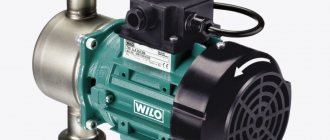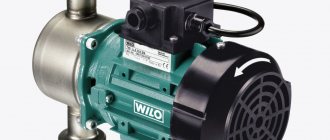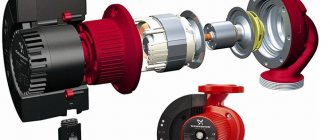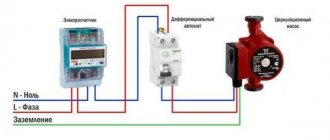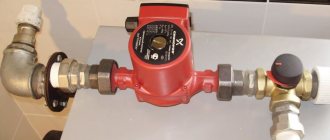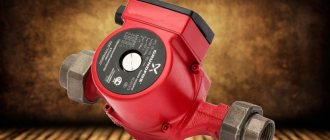The forced movement of the coolant in the water heating system is provided by a circulation pump capable of pumping liquid at a temperature of 110...115 °C. In private houses and apartments with individual heat sources, low-noise appliances of the household series with a coupling connection, equipped with a “wet” rotor (the motor armature is washed and cooled by flowing water), are used.
If you decide to choose a heating pump yourself, consider 3 main criteria:
- Technical characteristics - productivity, working pressure.
- Connecting and overall dimensions.
- Product price, brand popularity.
Let's consider point by point how to choose the right circulation pump for a radiator system, heated floors and the primary boiler circuit.
The most popular models of pumping units
Manufacturers offer a wide selection of equipment of different capacities, designed for pumping liquid media with various parameters. But we are only interested in flow-through models that operate in home heating and hot water supply networks.
How to distinguish circulation units from centrifugal and other types of pumps:
- in shape - the electric motor and impeller are installed in one housing, the pipes come out on the sides of the lower part (not in the middle);
- by the presence of a “wet” rotor, which significantly reduces the noise of impeller rotation;
- 2 standard sizes, installation length 130 and 180 mm;
- nominal diameter of the pipes is 15, 20, 25 and 32 mm, connection is coupling (threaded);
- nameplate pressure – 0.4, 0.6 and 0.8 Bar.
The specified parameters can be easily determined by the product labeling. Example: the numbers in the name Wilo Star-RS 15/4 indicate an internal diameter of the connecting pipes of 15 mm (DN 15) and a pressure of 4 m of water column (0.4 Bar). Example two: the Grundfos ALPHA2 25-60 device is connected to DN 25 pipes and develops a pressure of 0.6 Bar (6 meters).
Reference. Manufacturers usually release extended product lines. The German brand Wilo offers circulation blowers with a pressure of 2, 4, 6, 7 and 8 m of water. Art. But the “running” models still remain “fours” and “sixes”, less often – “eights”.
The design of a pump with a “wet” rotor
Of course, there are more powerful pumps, whose pressure reaches 1...10 Bar, but they are not used in private homes. Small units 130 mm long with ½ and ¾ inch pipes are usually installed inside boilers, large ones (18 cm, 1 and 1 ¼") are cut into the heating lines.
Advantages of small pumps
It is most profitable to use miniature pumps in buildings with an area of up to 500 m2. Uninterrupted operation of a central heating unit with a power of 30–60 W can be ensured by an emergency power supply. Moreover, this role does not necessarily have to be played by a generator with a gasoline engine.
In case of a sudden power outage, a regular car battery with a capacity of 80 Ah is suitable, which is enough for 12 hours of continuous operation of the central heating unit.
An inverter will help convert direct current into alternating current by increasing the voltage from 12 to 220 V. It must be connected to the pump through an electronic unit, which automatically activates reserve power. Then the heating will work regardless of power problems.
Small CN also has other useful properties:
- smooth start;
- long service life;
- no vibration;
- rotation speed switch.
Selecting a suitable pump must be based on a hydraulic calculation, which can only be performed by a trained specialist. It is much easier to purchase a central pump equipped with a speed switch in order to experimentally determine the optimal water speed in the pipes.
A temporary increase in pump performance in the presence of a solid fuel boiler speeds up the heating of the house after a long absence of the owners. When the air inside the room reaches the desired temperature, the pump speed is again reduced to save energy.
Pump selection methods
The most correct way is to make a full hydraulic calculation and accurately determine the main parameters of the pump - the developed pressure and productivity. This is exactly how centralized heat supply is designed for apartment buildings and industrial buildings.
Not all craftsmen involved in the installation of autonomous water systems are proficient in engineering calculation methods, let alone ordinary homeowners. How can you choose a circulation pump for heating in a simpler way:
- In case of replacing an old worn-out unit, a new one with similar parameters is purchased. The price and quality of the product come to the fore.
- Order a home heating system project from a heating engineer. Below we will explain the advantages of this option.
- Calculate the required pump pressure yourself using a simplified method.
- Trust the long-term practice of our experts and buy the device, guided by their advice.
Boiler room made by our expert Vladimir Sukhorukov. Convenient access to all equipment, including pumps
Expert recommendations. In country houses and apartments with an area of up to 250 m², a household pump that develops a pressure of 4 m of water column or 0.4 Bar is quite sufficient. For a square area of 250...500 m², it is better to buy a more powerful unit with a pressure of 6 m (0.6 bar), over 500 m² - 8 m of water. Art.
Ordering engineering calculations and design development costs money, but will pay off with interest. When you install heating yourself or hire workers, components and equipment are purchased with a decent supply - just in case. An intelligent designer will clearly justify why it is necessary to install a low-power pump and a pipe of a smaller diameter. The result will be savings on materials, and subsequently on electricity costs.
Types of pumps used in autonomous heat supply schemes
If you trust only numbers or want to check the installers, choose a heating pump based on your own calculations, using the method below. Don’t forget to check the calculated characteristics of the unit with the recommendations of experts - the result will probably be the same.
Which circulation pump is better
The best inexpensive circulation pump in our review is the proven and trouble-free VORTEX Ts-25/6. A model from the budget segment with a good balance of quality and characteristics has no complaints from buyers. The TOP in terms of price and reliability is headed by Grundfos UPS 25-40 180 - a reputable, internationally recognized brand that pleased us with its high, but acceptable price. Well-proven design, premium quality, such devices are used once for many years.
Confident “middle peasants” are approximately equal in the overall standings; the choice among them should be based solely on the technical characteristics and personal preferences of the companies. The rating of circulation pumps for the home or garden includes good brands that have earned user recognition for years.
Selection by size
You've probably noticed that the range of companies includes units with the same characteristics, but different dimensions and pipe sizes. How to select external pump parameters:
- For installation on pipelines, bypasses and mixing units of underfloor heating, standard blowers with a length of 180 mm are used. “Shorty” 130 mm are installed inside heat generators or on highways in very limited space.
- The diameter of the connecting pipes is selected to match the cross-section of the main pipeline. Increasing the standard size is permissible, but decreasing it is strictly not recommended. That is, a unit with 32 mm fittings can be installed on a DN 25 pipeline.
- Pumps with Ø32 mm nozzles are used on primary rings and boiler circuits, as well as in modernized gravity systems.
The performance characteristics of the pumps do not depend on their installation length - 130 or 180 mm
Note. The dimensions of ready-made bypasses sold in stores are adjusted to fit a standard pump with an installation length of 18 cm.
The number of supercharger speeds does not play a special role. At home, 3 modes are quite enough, the optimal speed is the second. The air from the units is bleed through the side screw, so you should not buy products with a separate air vent.
The best budget pumps for home heating systems
Such models are in the price category of up to 5 thousand rubles and are characterized by low power and performance. However, they are very stable in operation, have small dimensions and do not require specialized care.
CALIBER NTs-25/8-180
4.8
★★★★★
editorial assessment
89%
buyers recommend this product
The pump is driven by a single-phase asynchronous motor. The unit is distinguished by the presence of three power modes, characterized by maximum productivity from 3.6 to 9 cubic meters per hour.
Compact dimensions and operation with coolant temperatures up to 110 °C allow the device to be installed on any part of the heating system. A pressure of 10 atmospheres ensures stable operation in multi-storey buildings.
Advantages:
- small dimensions;
- ease of installation;
- 3 power modes;
- quiet work.
Flaws:
- instability to moisture and dust.
CALIBER NTs-25/8-180 is installed in residential buildings. It is worth purchasing for an extensive heating system in a country house or cottage, which includes a network of radiators and a “warm floor” system.
VORTEX TsN-32-6
4.8
★★★★★
editorial assessment
87%
buyers recommend this product
The advantages of the model include a long service life and adjustable pumping speed. The latter is done by rotating the impeller, which allows you to adjust the temperature as accurately as possible.
Stable operation over a long period of time is ensured thanks to the durable cast iron body, natural lubrication and cooling of the bearings, as well as the ability to remove air from the system.
Advantages:
- silent operation;
- durability;
- speed adjustment;
- small dimensions.
Flaws:
- weak pressure.
VORTEX TsN-32-6 is designed for installation in small areas. It is used in one-story houses, small apartments or commercial buildings.
UNIPUMP CP 25-60 180
4.7
★★★★★
editorial assessment
85%
buyers recommend this product
See review▶
The device's engine is protected against overheating, which ensures long-term operation under high loads.
The maximum productivity of the model is 53 liters per minute. The fluid pumping speed is controlled using a three-stage controller.
It is permissible to use not only water, but also other low-viscosity liquids as a coolant.
The pressure in the system is up to 10 atmospheres, due to which the pump remains stable when operating in highly branched heating systems.
Advantages:
- thermal protection;
- high pressure;
- performance;
- speed controller.
Flaws:
- no liquid filtration.
UNIPUMP CP will perform well in a one-story building. High performance makes it possible to successfully use the pump in large areas or to ensure the circulation of coolant in a single system for several buildings.
READ ALSO
10 best pellet boilers
Manufacturers and prices
Despite the wide range of pumps in stores, it is not easy to choose a truly high-quality product. The market is flooded with Chinese goods and counterfeits of famous brands. First, let's list the popular manufacturers in the CIS:
- The highest price category is Grundfos (Denmark), Wilo (Germany). Prices for original “Germans” start from 75 euros, “Grundfos” UPS series – 65 euros.
- Middle category – DAB, Aquario (Italy), Sprut (quality China). The cost of units of various models ranges from 40-100 euros.
- Other cheap pumps (Oasis, Neoclima, “Whirlwind”, “Caliber” and so on ad infinitum). Price – from 20 euros per piece.
The latest development is the Grundfos Alpfa-3 “smart” pump, which transmits information to a smartphone and helps balance the system
Comment. It is likely that we did not include some very worthy products in the highest or middle price category. The most common brands are listed here.
What is the difference between inexpensive and counterfeit pumps and high-quality superchargers:
- service life – 1…3 heating seasons;
- The product number is only on the sticker, the unit body is clean;
- pumping devices from the same batch often come with the same numbers;
- the weight of the fake is noticeably different from the original (it is lighter);
- A low-quality unit begins to make noise and squeak after working for 1 season in a closed heating system, and the housing gets very hot.
Sometimes counterfeit heating pumps are indistinguishable from the original, only the price is half the price. The secret is in the aluminum winding, which reduces the cost of the product. How to check: find a lot of the original model on the company’s official website and compare it with a market copy. Most likely, an informed seller will refuse to weigh a counterfeit device or will immediately recognize the unknown origin of the product.
Types of circulation devices
For domestic purposes, manufacturers produce two types of central heating units: with a wet and dry rotor. They have significant design differences, but work equally effectively in heating systems of residential buildings.
With wet rotor
The main difference between this central unit is the absence of seals between the volute and the engine housing. The rotor is located in an aqueous environment, which provides effective noise suppression and bearing lubrication during operation of the device. Electronic components and the stator winding are separated from the coolant by a sealed glass.
Water is 800 times denser than air, so it creates increased resistance to rotor rotation, which significantly reduces the efficiency of the pump. This drawback is more than compensated for by the simplicity and reliability of the device. The silent operation of the central heating unit allows it to be installed in residential premises.
Wet rotor pumps have the following technical characteristics:
- do not require maintenance;
- service life is 5–10 years;
- The efficiency of most models is 50–60%;
- There is virtually no noise or vibration during operation.
Important advantages of this type of central heating unit are its affordable price and simplicity of the device. The electric motor can be removed for repairs without dismantling the pump housing.
With dry rotor
The design of this type of central heating unit contains a sealed partition with o-rings between the “volatile” and the engine housing. Only the impeller is in contact with the coolant, and the electric motor rotor is located in the dry compartment. When rotating, there is no additional resistance to movement, so such pumps consume less energy.
These blowers have the following properties:
- Efficiency reaches 70-80%;
- operation time between repairs - 3 years;
- high noise level;
- require regular maintenance (MOT).
Due to their noisy operation, central pumps with a dry rotor are used mainly in industrial premises. If heat generating equipment is installed in a utility room of a residential building, then the use of such a pump will bring significant energy savings. But you will need to carefully monitor the sealing gaskets and change them in time during the next maintenance.
Prices for the range of circulation pumps
circulation pump
Video
This video shows an example of improper installation of a bypass with a circulation pump at the outlet of the boiler: the inconvenient location of the unit prevented the proper placement of the heating pipelines; in this position, the central heating unit will overheat and quickly fail.
Watch the video where a consumer with experience in operating different types of central pumps explains the benefits of installing a three-speed pump. Read about energy-saving wall-mounted quartz heaters for the home on our website.
The specialist tells how to make a preliminary calculation of the characteristics of the central heating unit using the example of a house with an area of 300 m2.
Dry pumps
If there is water inside a wet-type pump, then in a dry-type pump only the impeller comes into contact with the liquid. The rotor and the entire electrical circuit are protected by a casing. He is not washed with water. A casing with gaskets prevents fluid from entering the electric motor.
The motor is plugged in and press “start”. The clutch begins to rotate, which makes the impeller work. The impeller blades, in turn, portionwise capture water from the storage tank and move it towards the boiler.
The advantage of dry type pumps is that airing is eliminated. Work becomes more efficient. The pump has some disadvantages. It needs to be lubricated regularly. In a wet type device, this function is performed by water.
